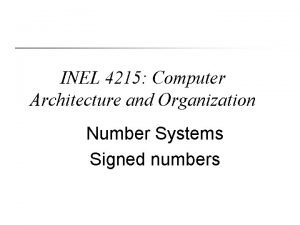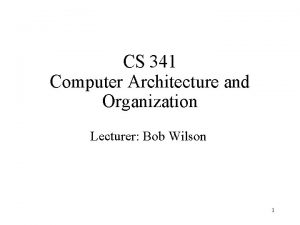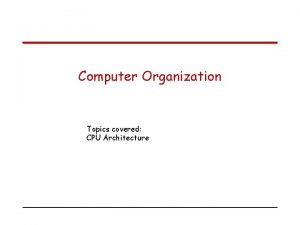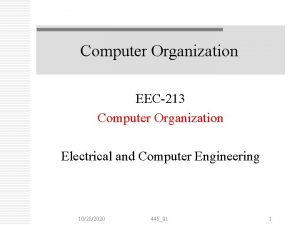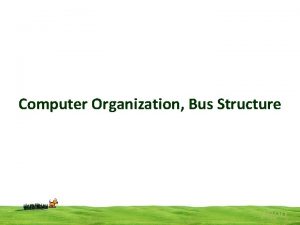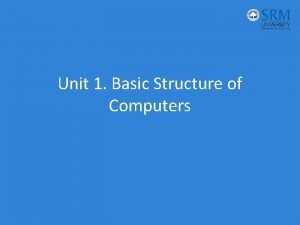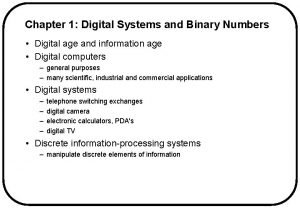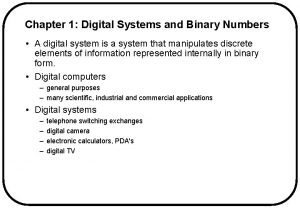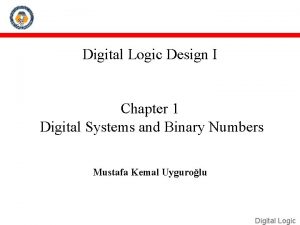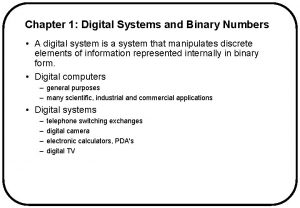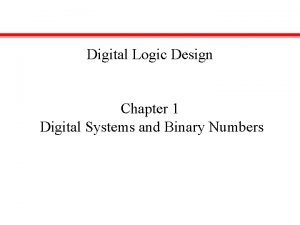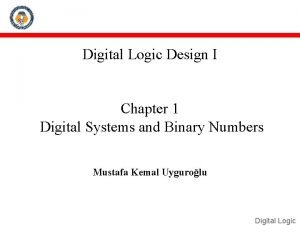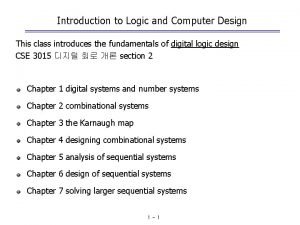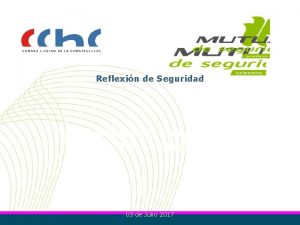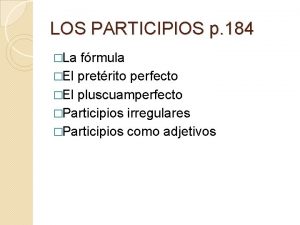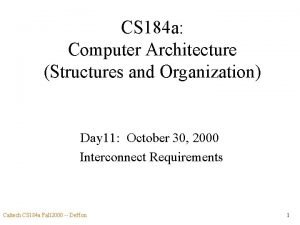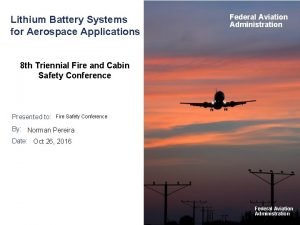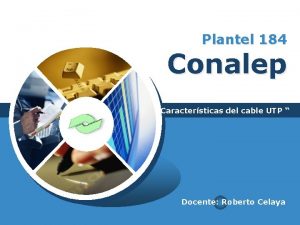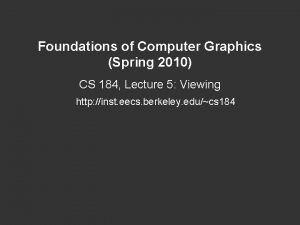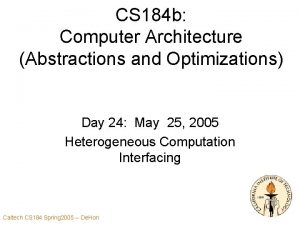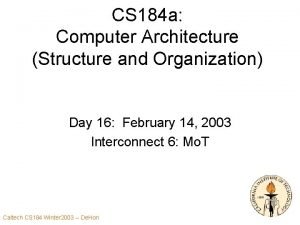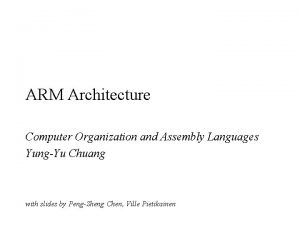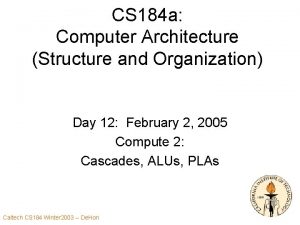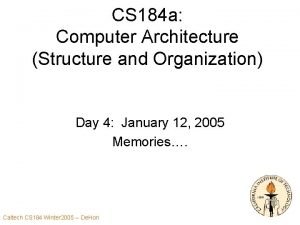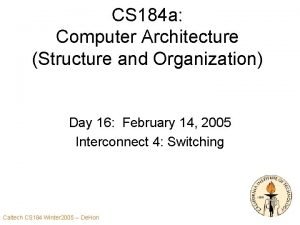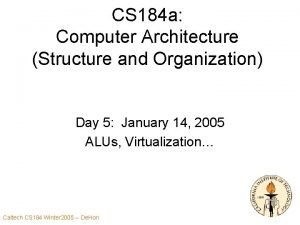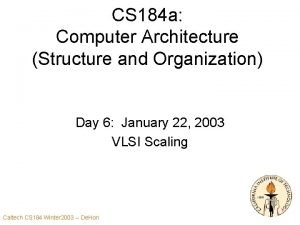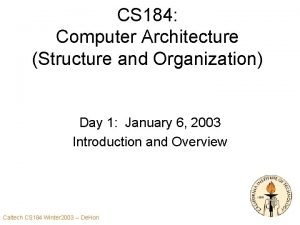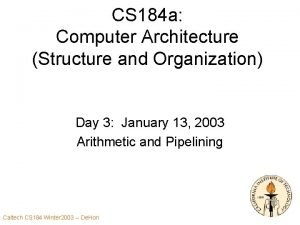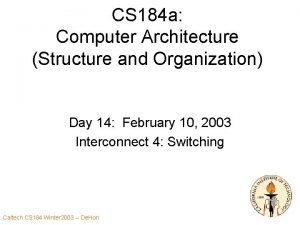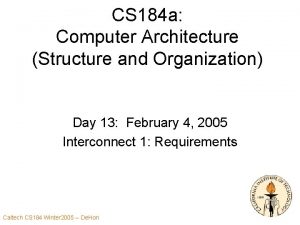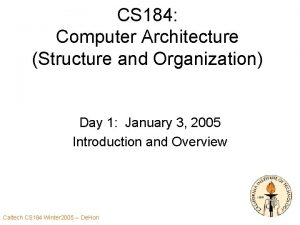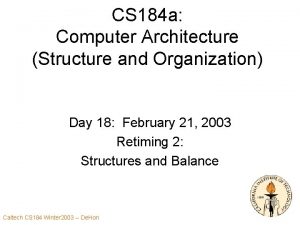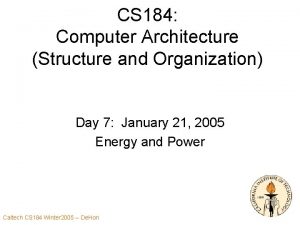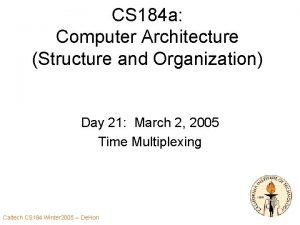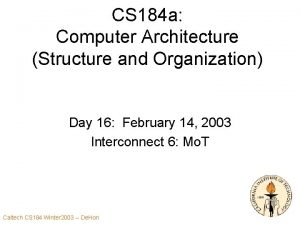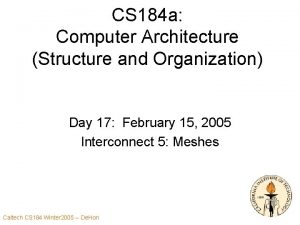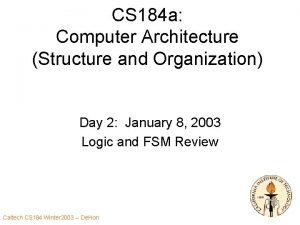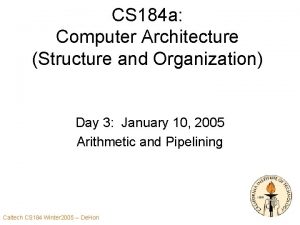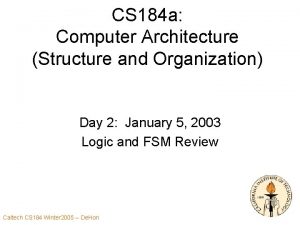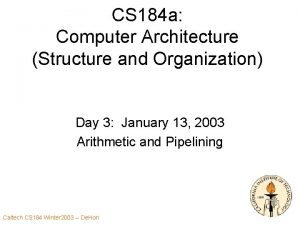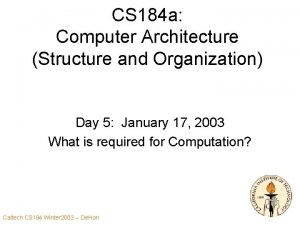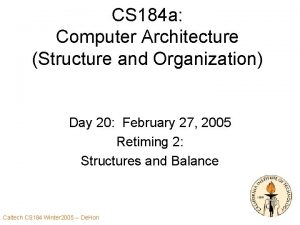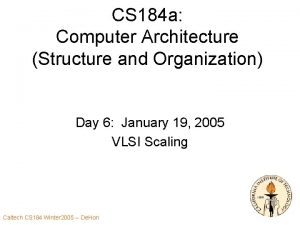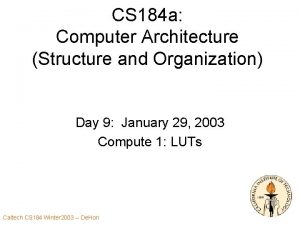CS 184 a Computer Architecture Structure and Organization














































![Big Ideas [MSB Ideas] • Raw densities: custom: ga: fpga: processor – 1: 5: Big Ideas [MSB Ideas] • Raw densities: custom: ga: fpga: processor – 1: 5:](https://slidetodoc.com/presentation_image_h2/6198878455c9d2242613b4f31d3e6e2b/image-47.jpg)
- Slides: 47

CS 184 a: Computer Architecture (Structure and Organization) Day 10: January 28, 2005 Empirical Comparisons Caltech CS 184 Winter 2005 -- De. Hon 1

Last Time • Instruction Space Modeling Caltech CS 184 Winter 2005 -- De. Hon 2

Today • Empirical Data – Processors – FPGAs – Custom • Gate Array • Std. Cell • Full – Tasks Caltech CS 184 Winter 2005 -- De. Hon 3

Empirical Comparisons Caltech CS 184 Winter 2005 -- De. Hon 4

Empirical • Ground modeling in some concretes • Start sorting out – custom vs. configurable – spatial configurable vs. temporal Caltech CS 184 Winter 2005 -- De. Hon 5

Full Custom • Get to define all layers • Use any geometry you like • Only rules are process design rules • CS 181 Caltech CS 184 Winter 2005 -- De. Hon 6

Standard Cell Area inv nand 3 inv AOI 4 Cell area nor 3 Inv All cells uniform height Width of channel determined by routing Identify the full custom and standard cell regions on 386 DX die http: //microscope. fsu. edu/chipshots/intel/386 dxlarge. html 7 Caltech CS 184 Winter 2005 -- De. Hon

MPGA • Metal Programmable Gate Array • Gates pre-placed (poly, diffusion) • Only get to define metal connections – Cheap – only have to pay for metal mask(s) Caltech CS 184 Winter 2005 -- De. Hon 8

MPGA vs. Custom? • AMI CICC’ 83 – MPGA 1. 0 – Std-Cell 0. 7 – Custom 0. 5 • Toshiba DSP – Custom 0. 3 • Mosaid RAM – Custom 0. 2 Caltech CS 184 Winter 2005 -- De. Hon • GE CICC’ 86 – MPGA 1. 0 – Std-Cell 0. 4 --0. 7 • FF/counter 0. 7 • Full. Adder 0. 4 • RAM 0. 2 MPGA = Metal Programmable Gate Array (traditional Gate Array) 9

Metal Programmable Gate Arrays Caltech CS 184 Winter 2005 -- De. Hon 10

MPGAs • Modern -- “Sea of Gates” • yield 35 --70% • maybe 5 kl 2/gate ? – (quite a bit of variance) Caltech CS 184 Winter 2005 -- De. Hon 11

FPGA Table Caltech CS 184 Winter 2005 -- De. Hon 12

Modern FPGAs • APEX 20 K 1500 E § 52 K LEs § 0. 18 mm § 24 mm 22 mm § 1. 25 Ml 2/LE • XC 2 V 1000 § 10. 44 mm x 9. 90 mm [source: Chipworks] § 0. 15 mm § 11, 520 4 -LUTs § 1. 5 Ml 2/4 -LUT [Both also have RAM in cited area] Caltech CS 184 Winter 2005 -- De. Hon 13

Conventional FPGA Tile K-LUT (typical k=4) w/ optional output Flip-Flop Caltech CS 184 Winter 2005 -- De. Hon 14

Toronto FPGA Model Caltech CS 184 Winter 2005 -- De. Hon 15

How many gates? Caltech CS 184 Winter 2005 -- De. Hon 16

“gates” in 2 -LUT Caltech CS 184 Winter 2005 -- De. Hon 17

Now how many? Caltech CS 184 Winter 2005 -- De. Hon 18

Which gives: More usable gates? More gates/unit area? Caltech CS 184 Winter 2005 -- De. Hon 19

Gates Required? Depth=3, Depth=2048? Caltech CS 184 Winter 2005 -- De. Hon 20

Gate metric for FPGAs? • Day 8: several components for computations – compute element – interconnect: • space • time – instructions • Not all applications need in same balance • Assigning a single “capacity” number to device is an oversimplification Caltech CS 184 Winter 2005 -- De. Hon 21

MPGA vs. FPGA • MPGA (SOG GA) – 5 Kl 2/gate – 35 -70% usable (50%) – 7 -17 Kl 2/gate net • Xilinx XC 4 K – 1. 25 Ml 2 /CLB – 17 --48 gates (26? ) – 26 -73 Kl 2/gate net • Ratio: 2 --10 (5) Adding ~2 x Custom/MPGA, Custom/FPGA ~10 x Caltech CS 184 Winter 2005 -- De. Hon 22

MPGA vs. FPGA • MPGA (SOG GA) l=0. 6 m tgd~1 ns • Xilinx XC 4 K l=0. 6 m 1 -7 gates in 7 ns 2 -3 gates typical • Ratio: 1 --7 (2. 5) Caltech CS 184 Winter 2005 -- De. Hon 23

Processors vs. FPGAs Caltech CS 184 Winter 2005 -- De. Hon 24

Processors and FPGAs Caltech CS 184 Winter 2005 -- De. Hon 25

Component Example • Single die in 0. 35 mm XC 4085 XL-09 3, 136 CLBs 682 Bit Ops/ns Alpha 1996 2 64 b ALUs 55. 7 Bit Ops/ns 4. 6 ns 2. 3 ns [1 “bit op” = 2 gate evaluations] Caltech CS 184 Winter 2005 -- De. Hon 26

Processors and FPGAs Caltech CS 184 Winter 2005 -- De. Hon 27

Raw Density Summary • Area – MPGA 2 -3 x Custom – FPGA 5 x MPGA • Area-Time – Gate Array 6 -10 x Custom – FPGA 15 -20 x Gate Array – Processor 10 x FPGA Caltech CS 184 Winter 2005 -- De. Hon 28

Raw Density Caveats • Processor/FPGA may solve more specialized problem • Problems have different resource balance requirements – …can lead to low yield of raw density Caltech CS 184 Winter 2005 -- De. Hon 29

Homework • Day behind • Current assignment – Involves cascades PLAs Caltech CS 184 Winter 2005 -- De. Hon 30

Task Comparisons Caltech CS 184 Winter 2005 -- De. Hon 31

Broadening Picture • Compare larger computations • For comparison – throughput density metric: results/area-time • normalize out area-time point selection • high throughput density most in fixed area least area to satisfy fixed throughput target Caltech CS 184 Winter 2005 -- De. Hon 32

Multiply Caltech CS 184 Winter 2005 -- De. Hon 33

Example: FIR Filtering Yi=w 1 xi+w 2 xi+1+. . . Application metric: TAPs = filter taps multiply accumulate Caltech CS 184 Winter 2005 -- De. Hon 34

IIR/Biquad Simplest IIR: Yi=A Xi+B Yi-1 Caltech CS 184 Winter 2005 -- De. Hon 35

DES Keysearch <http: //www. cs. berkeley. edu/~iang/isaac/hardware/> Caltech CS 184 Winter 2005 -- De. Hon 36

DNA Sequence Match • Problem: “cost” of transform S 1 S 2 • Given: cost of insertion, deletion, substitution • Relevance: similarity of DNA sequences – evolutionary similarity – structure predict function • Typically: new sequence compared to large databse Caltech CS 184 Winter 2005 -- De. Hon 37

DNA Sequence Match Caltech CS 184 Winter 2005 -- De. Hon 38

Floating-Point Add (single prec. ) Caltech CS 184 Winter 2005 -- De. Hon 39

Floating-Point Mpy (single prec. ) Caltech CS 184 Winter 2005 -- De. Hon 40

FPGA vs. Processor FP (Double Precision FP MAC) Caltech CS 184 Winter 2005 -- De. Hon [Underwood/FPGA’ 2004] 41

Degrade from Peak Caltech CS 184 Winter 2005 -- De. Hon 42

Degrade from Peak: FPGAs • Long path length not run at cycle • Limited throughput requirement – bottlenecks elsewhere limit throughput req. • Insufficient interconnect • Insufficient retiming resources (bandwidth) Caltech CS 184 Winter 2005 -- De. Hon 43

Degrade from Peak: Processors • Ops w/ no gate evaluations (interconnect) • Ops use limited word width • Stalls waiting for retimed data Caltech CS 184 Winter 2005 -- De. Hon 44

Degrade from Peak: Custom/MPGA • Solve more general problem than required – (more gates than really need) • Long path length • Limited throughput requirement • Not needed or applicable to a problem Caltech CS 184 Winter 2005 -- De. Hon 45

Degrade Notes • We’ll cover these issues in more detail as we get into them later in the course Caltech CS 184 Winter 2005 -- De. Hon 46
![Big Ideas MSB Ideas Raw densities custom ga fpga processor 1 5 Big Ideas [MSB Ideas] • Raw densities: custom: ga: fpga: processor – 1: 5:](https://slidetodoc.com/presentation_image_h2/6198878455c9d2242613b4f31d3e6e2b/image-47.jpg)
Big Ideas [MSB Ideas] • Raw densities: custom: ga: fpga: processor – 1: 5: 1000 – close gap with specialization Caltech CS 184 Winter 2005 -- De. Hon 47
 Computer architecture and organisation
Computer architecture and organisation Basic structure of a computer
Basic structure of a computer Computer organization and architecture 10th solution
Computer organization and architecture 10th solution Ripple carry adder virtual lab
Ripple carry adder virtual lab Introduction to computer organization and architecture
Introduction to computer organization and architecture Computer organization & architecture: themes and variations
Computer organization & architecture: themes and variations Computer organization and architecture 10th edition
Computer organization and architecture 10th edition Computer arithmetic
Computer arithmetic Computer organization and architecture definition
Computer organization and architecture definition One's complement
One's complement Computer architecture and organization
Computer architecture and organization Process organization in computer organization
Process organization in computer organization Bus architecture in computer architecture
Bus architecture in computer architecture Instruction set architecture in computer organization
Instruction set architecture in computer organization Memory organization in computer architecture
Memory organization in computer architecture Design of basic computer
Design of basic computer Interrupt cycle flow chart
Interrupt cycle flow chart Single bus structure in computer organization
Single bus structure in computer organization Memory data register
Memory data register Three bus structure in computer organization
Three bus structure in computer organization The basic structure of computer was developed by
The basic structure of computer was developed by Bcd addition of 184 and 576
Bcd addition of 184 and 576 Rh nomenclature
Rh nomenclature Binary code example
Binary code example Bcd addition of 184 and 576
Bcd addition of 184 and 576 Bcd addition of 184 and 576
Bcd addition of 184 and 576 Bcd addition of 184 and 576
Bcd addition of 184 and 576 Binary hexadecimal octal decimal table
Binary hexadecimal octal decimal table Bcd addition of 184 and 576
Bcd addition of 184 and 576 Point by point organization essay
Point by point organization essay Art 184
Art 184 P 184
P 184 Negation asl
Negation asl 4-sinf ona tili
4-sinf ona tili 4 184 joules
4 184 joules Cs 184
Cs 184 Cs 184
Cs 184 Rtca do-347
Rtca do-347 Conalep coacalco
Conalep coacalco Cs 184 berkeley
Cs 184 berkeley P 184
P 184 184 bao
184 bao Tck 184
Tck 184 Art 187 lgt
Art 187 lgt Rua diogo moreira 184
Rua diogo moreira 184 Cs 184
Cs 184 Cs184
Cs184 Arm in computer organization
Arm in computer organization









